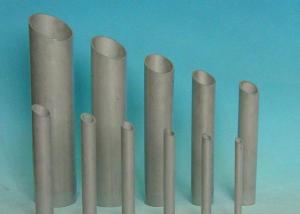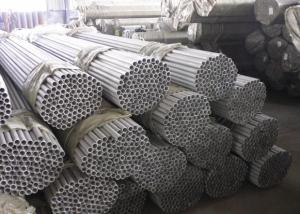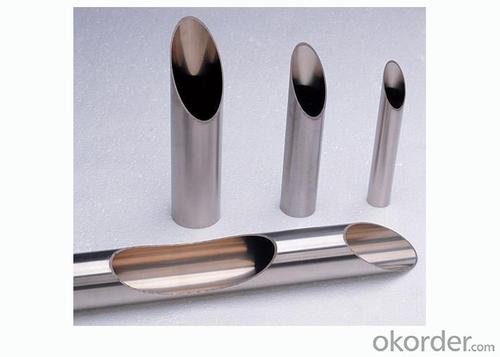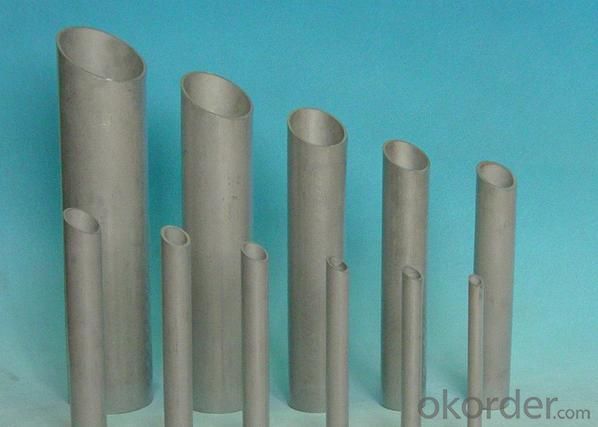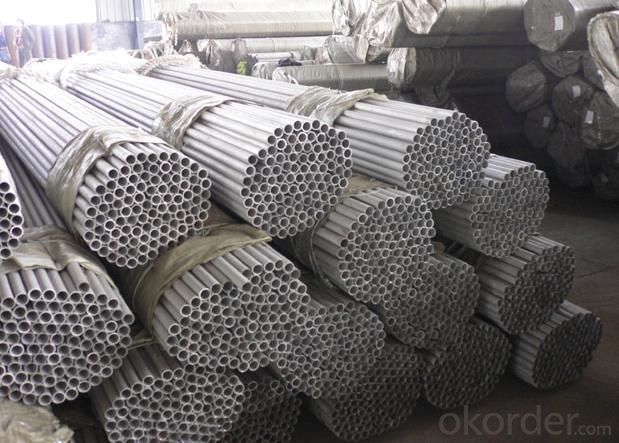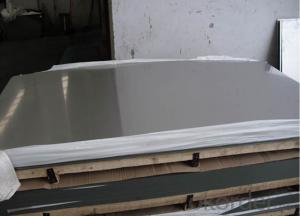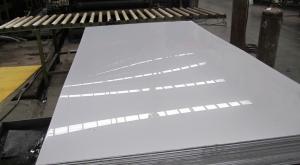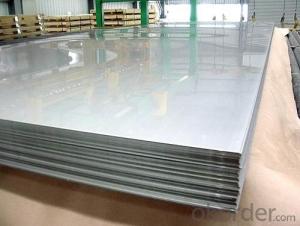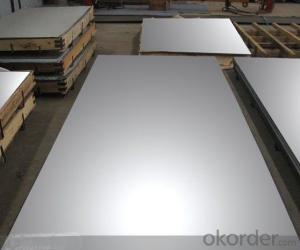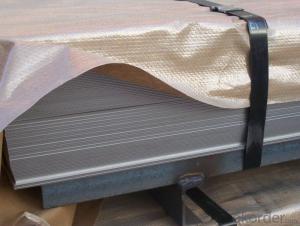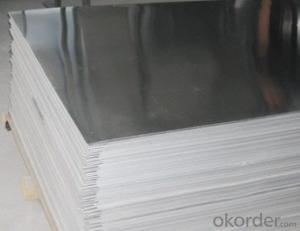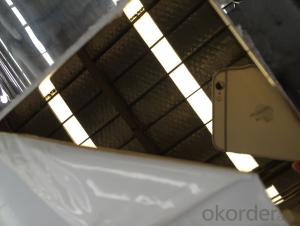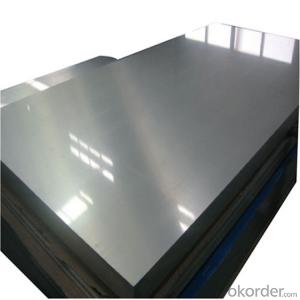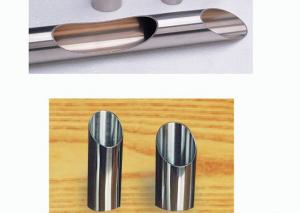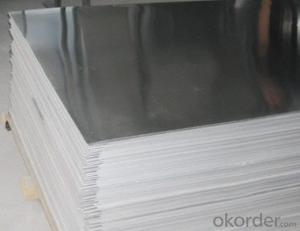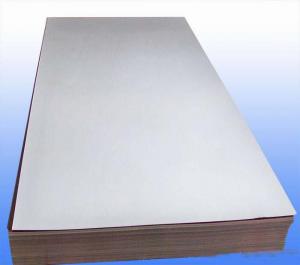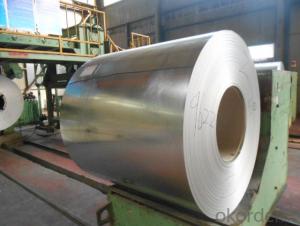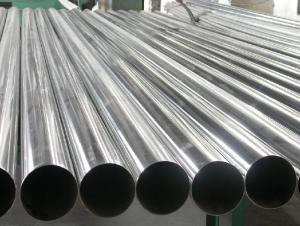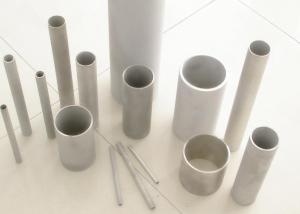304 Stainless Steel Seamless Tubing
- Loading Port:
- China Main Port
- Payment Terms:
- TT or LC
- Min Order Qty:
- 5 Tons m.t.
- Supply Capability:
- 10000TON/M m.t./month
OKorder Service Pledge
OKorder Financial Service
You Might Also Like
304 Stainless Steel Seamless Pipe
Application Of 304 Stainless Steel Seamless Pipe
Construction industry.
Chemical industry
Water tube
Pulp&Paper making industry
Heat exchanger tube,boiler tube,condenser tube,etc.
Available size range of 304 L Stainless Steel Seamless Pipe
OUTSIDE DIAMETER | WALL THICKNESS | |||||||
INCH | MM | Sch10 | Sch40 | STD | Sch80 | XS | Sch160 | XXS |
1/8" | 10.29 | 1.24 | 1.73 | 1.73 | 2.41 | 2.41 | - | - |
1/4" | 13.72 | 1.65 | 2.24 | 2.24 | 3.02 | 3.02 | - | - |
3/8” | 17.15 | 1.65 | 2.31 | 2.31 | 3.20 | 3.20 | - | - |
1/2" | 21.34 | 2.11 | 2.77 | 2.77 | 3.73 | 3.73 | 4.78 | 7.47 |
3/4 " | 26.67 | 2.11 | 2.87 | 2.87 | 3.91 | 3.91 | 5.56 | 7.82 |
1'' | 33.40 | 2.77 | 3.38 | 3.38 | 4.55 | 4.55 | 6.35 | 9.09 |
1.1/4" | 42.16 | 2.77 | 3.56 | 3.56 | 4.85 | 4.85 | 6.35 | 9.70 |
1.1/2'' | 48.30 | 2.77 | 3.68 | 3.68 | 5.08 | 5.08 | 7.14 | 10.15 |
2" | 60.30 | 2.77 | 3.91 | 3.91 | 5.54 | 5.54 | 8.74 | 11.07 |
2 1/2" | 73.03 | 3.05 | 5.16 | 5.16 | 7.01 | 7.01 | 9.53 | 14.02 |
3" | 88.90 | 3.05 | 5.49 | 5.49 | 7.62 | 7.62 | 11.13 | 15.24 |
3 1/2” | 101.60 | 3.05 | 5.74 | 5.74 | 8.08 | 8.08 | - | - |
4'' | 114.30 | 3.05 | 6.02 | 6.02 | 8.56 | 8.56 | 13.49 | 17.12 |
5” | 141.30 | 3.40 | 6.55 | 6.55 | 9.52 | 9.52 | 15.88 | 19.05 |
6" | 168.30 | 3.40 | 7.11 | 7.11 | 10.97 | 10.97 | 18.26 | 21.96 |
8'' | 219.08 | 3.76 | 8.18 | 8.18 | 12.70 | 12.70 | 23.01 | 22.23 |
10” | 273.05 | 4.19 | 9.27 | 9.27 | 15.08 | 12.70 | 28.58 | 25.40 |
12" | 323.85 | 4.57 | 9.52 | 9.53 | 17.45 | 12.70 | 33.32 | 25.40 |
14" | 355.60 | 4.78 | 11.13 | 9.53 | 19.05 | 12.70 | 35.71 | - |
16" | 406.40 | 4.78 | 12.70 | 9.53 | 21.44 | 12.70 | 40.49 | - |
18" | 457.20 | 4.78 | 14.27 | 9.53 | 23.83 | 12.70 | 45.24 | - |
20" | 508.00 | 5.54 | 15.09 | 9.53 | 26.19 | 12.70 | 50.01 | - |
22" | 558.80 | 5.54 | - | 9.53 | 28.58 | 12.70 | 53.98 | - |
24" | 609.60 | 6.35 | 17.48 | 9.53 | 30.96 | 12.70 | 59.54 | - |
Note : We can also produce the sizes beyond this table according to the requirements of customers
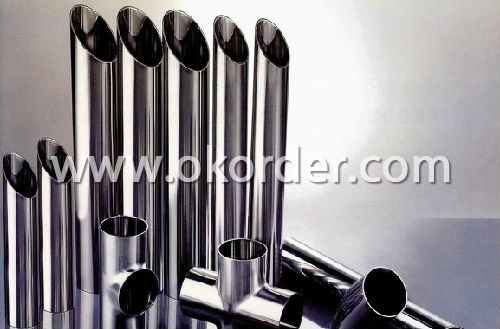
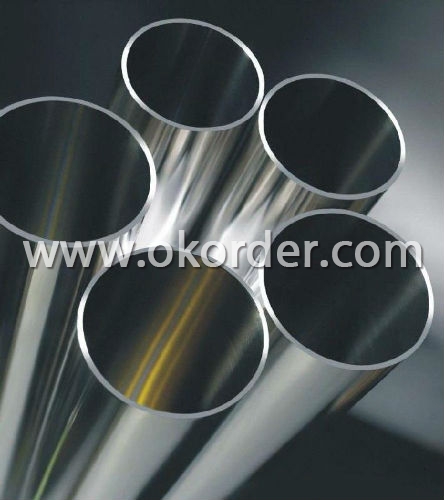
- Q: Can stainless steel sheets be used for decorative elevator doors or panels?
- Yes, stainless steel sheets can be used for decorative elevator doors or panels. Stainless steel is a versatile material that offers a polished and modern appearance, making it a popular choice for decorative applications. It is known for its durability, resistance to corrosion, and easy maintenance, making it suitable for high-traffic areas like elevator doors and panels. Additionally, stainless steel sheets can be customized with various finishes, patterns, and textures, allowing for endless design possibilities. Whether it's a sleek and minimalist look or a more intricate and decorative design, stainless steel sheets can enhance the aesthetics of elevator doors and panels while providing long-lasting functionality.
- Q: What is the bending strength of stainless steel sheets?
- The bending strength of stainless steel sheets can vary depending on the specific grade and thickness of the sheet. However, stainless steel is generally known for its high strength and rigidity, making it suitable for various applications that require strong and durable materials.
- Q: How do you attach stainless steel sheets to a wall?
- To attach stainless steel sheets to a wall, there are a few common methods you can consider: 1. Adhesive: Using a high-strength construction adhesive specifically designed for metal bonding, apply it to the backside of the stainless steel sheet. Press the sheet firmly against the wall and hold it in place until the adhesive cures. This method is suitable for smaller, lightweight stainless steel sheets. 2. Screw fasteners: Drill holes through the stainless steel sheet and into the wall at regular intervals. Use stainless steel screws that are appropriate for the thickness of the sheet and the wall material. Insert the screws into the holes and tighten them until the sheet is securely attached to the wall. This method works well for larger and heavier stainless steel sheets. 3. Magnetic mounting: If the stainless steel sheet is magnetizable, you can use magnets to attach it to a metal wall. Place strong magnets on the backside of the sheet, aligning them with the corresponding magnets on the wall. The magnets will hold the sheet in place, allowing for easy installation and removal. 4. Panel mounting systems: Some manufacturers offer panel mounting systems specifically designed for stainless steel sheets. These systems typically consist of brackets or clips that attach to the backside of the sheet and then hook onto a track or rail system mounted on the wall. This method provides a secure and visually appealing attachment solution. When attaching stainless steel sheets to a wall, it's important to ensure that the wall surface is clean, dry, and properly prepared. This will help optimize the adhesion and prevent any potential issues. Additionally, always follow the manufacturer's instructions and guidelines for the specific method or product you are using.
- Q: Are stainless steel sheets resistant to galvanic corrosion?
- Indeed, galvanic corrosion can be prevented by using stainless steel sheets. When dissimilar metals encounter each other in the presence of an electrolyte like moisture or saltwater, galvanic corrosion ensues. The process involves one metal acting as an anode and the other as a cathode, resulting in the transfer of electrons and corrosion of the anode. Stainless steel, an alloy that incorporates chromium, possesses a passive oxide layer on its surface. This layer serves as a protective shield, impeding the transfer of electrons and effectively combatting galvanic corrosion. The chromium in stainless steel reacts with oxygen in the atmosphere, generating a thin, invisible, and self-rejuvenating layer of chromium oxide. This exceptional layer provides outstanding corrosion resistance, rendering stainless steel highly resistant to galvanic corrosion when combined with other metals. Nevertheless, it is worth noting that the level of corrosion resistance can vary depending on the specific grade and composition of stainless steel employed. Some stainless steel alloys, such as Type 316 stainless steel, offer even greater resistance to galvanic corrosion due to the inclusion of molybdenum, which bolsters its corrosion resistance in aggressive environments. In conclusion, stainless steel sheets typically exhibit remarkable resistance to galvanic corrosion due to the presence of a passive chromium oxide layer on their surface. This makes stainless steel an excellent choice for applications where galvanic corrosion poses a concern, such as marine environments or when in contact with dissimilar metals.
- Q: What are the different welding techniques used for stainless steel sheets?
- There are several welding techniques commonly used for stainless steel sheets, including Tungsten Inert Gas (TIG) welding, Metal Inert Gas (MIG) welding, and Shielded Metal Arc Welding (SMAW). TIG welding is often preferred for its precise control and ability to produce high-quality welds with minimal distortion. MIG welding is a faster process that uses a consumable wire electrode and an inert gas to protect the weld zone. SMAW, also known as stick welding, is a versatile technique that can be used in various positions and is suitable for thicker stainless steel sheets. Each technique has its advantages and is chosen based on factors such as the thickness of the sheets, desired weld quality, and application requirements.
- Q: What is the specific heat capacity of stainless steel sheets?
- The specific heat capacity of stainless steel sheets typically ranges from 0.46 to 0.51 joules per gram per degree Celsius.
- Q: What are the benefits of using embossed stainless steel sheets in elevator interiors?
- There are several benefits of using embossed stainless steel sheets in elevator interiors. Firstly, embossed stainless steel sheets add a touch of elegance and sophistication to the overall design of the elevator. The embossed patterns create a visually appealing surface that can enhance the aesthetic appeal of the interior space. This is especially important in commercial buildings and high-end residential complexes where a luxurious ambiance is desired. Secondly, embossed stainless steel sheets are highly durable and resistant to wear and tear. Elevator interiors are subject to constant use and can be prone to scratches, dents, and other damages. The embossed pattern on the stainless steel surface helps to hide minor imperfections, ensuring that the interior maintains its pristine appearance for a longer period of time. Additionally, stainless steel is known for its corrosion resistance, making it a suitable choice for environments with high humidity levels, such as elevator shafts. Furthermore, embossed stainless steel sheets are easy to clean and maintain. Elevator interiors are often exposed to dirt, fingerprints, and other stains. The smooth surface of the embossed stainless steel makes it easy to wipe away these marks, ensuring that the interior always looks clean and well-maintained. This is particularly important in public spaces where cleanliness is essential for creating a positive impression on users. Additionally, embossed stainless steel sheets offer a high level of customization. They can be manufactured in various patterns, textures, and finishes, allowing for endless design possibilities. This enables architects and designers to create unique and personalized elevator interiors that reflect the desired theme or branding of a building. The versatility of embossed stainless steel also makes it easy to match with other interior design elements, such as flooring, lighting fixtures, and wall coverings. In conclusion, the benefits of using embossed stainless steel sheets in elevator interiors include enhanced visual appeal, durability, ease of maintenance, and customization options. These qualities make embossed stainless steel an ideal material for elevators in various settings, from commercial buildings to residential complexes, adding value and elegance to the overall design.
- Q: How do you install stainless steel sheets?
- To install stainless steel sheets, start by measuring and marking the area where you want to install them. Then, use a circular saw or a metal shear to cut the sheets to the desired size. Next, clean the surface where the sheets will be installed and remove any debris or dust. Apply adhesive or a construction-grade adhesive tape to the back of the stainless steel sheet and carefully place it onto the prepared surface, ensuring it is aligned correctly. Use a roller or a block of wood to press the sheet firmly to the wall to ensure proper adhesion. Finally, secure the sheets in place with construction-grade adhesive or stainless steel screws, ensuring they are evenly spaced.
- Q: Can stainless steel sheets be used in marine environments?
- Yes, stainless steel sheets can be used in marine environments. Stainless steel is highly resistant to corrosion, making it suitable for marine applications where it will be exposed to saltwater and high humidity. It is commonly used in marine vessels, offshore platforms, and other structures that require durability and resistance to rust and corrosion.
- Q: Are stainless steel sheets good for industrial exhaust systems?
- Indeed, stainless steel sheets prove to be an exceptional option for industrial exhaust systems. Renowned for its exceptional resistance to corrosion, stainless steel stands as an immensely sturdy and enduring material for exhaust systems. It exhibits the capability to endure high temperatures and withstand extreme weather conditions, hence rendering it suitable for deployment in industrial settings. Moreover, stainless steel showcases outstanding strength, enabling it to cope with the pressure and vibrations inherent in exhaust systems. Furthermore, stainless steel boasts effortless cleaning and maintenance, a crucial attribute for ensuring efficient functionality of the exhaust system. In summary, the durability, corrosion resistance, and high temperature tolerance of stainless steel sheets make them an outstanding choice for industrial exhaust systems.
1. Manufacturer Overview
| Location | Zhejiang, China |
| Year Established | 2005 |
| Annual Output Value | Above US$1.6 million |
| Main Markets | Europe, North America. |
| Company Certifications |
2. Manufacturer Certificates
| a) Certification Name | |
| Range | |
| Reference | |
| Validity Period |
3. Manufacturer Capability
| a) Trade Capacity | |
| Nearest Port | Shanghai |
| Export Percentage | 40% |
| No.of Employees in Trade Department | Above 30 people |
| Language Spoken: | English, Chinese |
| b) Factory Information | |
| Factory Size: | Above 5000 square meter |
| No. of Production Lines | Above 6 |
| Contract Manufacturing | OEM Service Offered |
| Product Price Range | Average |
Send your message to us
304 Stainless Steel Seamless Tubing
- Loading Port:
- China Main Port
- Payment Terms:
- TT or LC
- Min Order Qty:
- 5 Tons m.t.
- Supply Capability:
- 10000TON/M m.t./month
OKorder Service Pledge
OKorder Financial Service
Similar products
Hot products
Hot Searches
Related keywords

